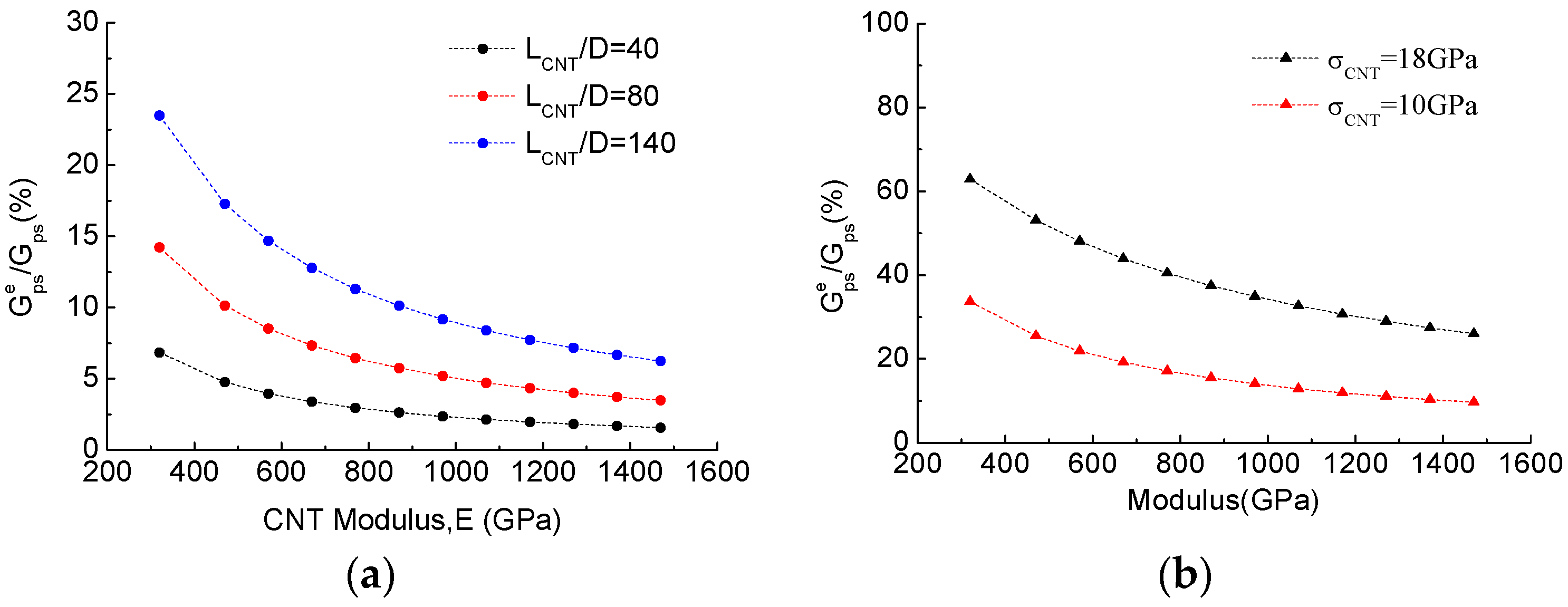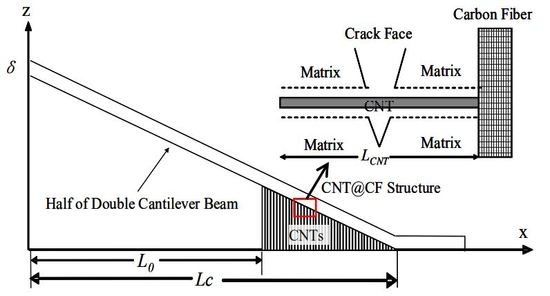An Analytical Model of Interlaminar Fracture of Polymer Composite Reinforced by Carbon Fibres Grafted with Carbon Nanotubes
Abstract
:1. Introduction
2. Critical Toughness of Mode I Delamination of Laminate Reinforced by CNT@CF
3. CNT Toughening Mechanisms and Their Bridging Laws in DCB Delamination
- (1)
- The CNTs are treated as unidirectional and straight multi-wall nanotubes without defects, and they are radially and uniformly grown on the surface of carbon fibres and then embedded into epoxy matrix to produce the CNTs@CFs hybrid structure.
- (2)
- (3)
3.1. CNT Matrix Pullout Laws
3.2. CNT Sword-In-Sheath Pullout Laws
4. Toughness Models and Numerical Study
4.1. CNT Pullout Model
4.2. CNT Sword-In-Sheath Model
4.3. Validation of Toughness Models
4.4. Characterization of Delamination Properties
5. Parametric Study and Discussion
5.1. Effect of CNT Elastic Deformation on Toughness
5.2. Effect of CNT@CF Grafting Stress on Toughness
6. Conclusions
- (1)
- The present model can predict fully detailed delamination properties, such as crack resistance load versus displacement, crack resistance load versus crack propagation, and fracture toughness versus crack propagation in DCB testing.
- (2)
- Different toughening mechanisms yield different delamination properties. Specifically, the CNT pullout mechanism results in a higher crack resistance load in R curves/load-displacement curves and leads to the concave curve type as the feature of GR-curves. In contrast, the CNT sword-in-sheath mechanism results in a lower crack resistance load in R curves/load-displacement curves and yields the convex curve type as the feature of GR-curves.
- (3)
- Strengthening the CNT@CF interface is an efficient strategy to obtain significant toughness improvement. Furthermore, CNT modulus and failure strength have important roles in toughness improvement in the CNT sword-in-sheath mechanism, but such effects were not evident in the CNT pullout mechanism.
- (4)
- Compared with other existing models, our model as presented in simulation provides better prediction and more information about DCB delamination behaviours.
Author Contributions
Funding
Acknowledgments
Conflicts of Interest
References
- Ju, H.; Baschnagel, F.; Rohr, V.; Terrasi, G.P. Fretting Fatigue Behaviour of Pin-Loaded Thermoset Carbon-Fibre-Reinforced Polymer (CFRP) Straps. Polymers 2016, 8, 124. [Google Scholar] [CrossRef]
- Zhu, J.H.; Wei, L.; Guo, G.; Zhu, A. Mechanical and Electrochemical Performance of Carbon Fiber Reinforced Polymer in Oxygen Evolution Environment. Polymers 2016, 8, 393. [Google Scholar] [CrossRef]
- Pappas, G.; Joncas, S.; Michaud, V.; Botsis, J. The influence of through-thickness reinforcement geometry and pattern on delamination of fiber-reinforced composites: Part II—Modeling. Compos. Struct. 2017, 181, 379–390. [Google Scholar] [CrossRef]
- Steeves, C.A.; Flech, N.A. In-plane properties of composite laminates with through-thickness pin reinforcement. Int. J. Solids. Struct. 2006, 43, 3197–3212. [Google Scholar] [CrossRef]
- Borowski, E.; Soliman, E.; Kandil, U.F.; Taha, M.R. Interlaminar fracture toughness of CFRP laminates incorporating multi-walled carbon nanotubes. Polymers 2015, 7, 1020–1045. [Google Scholar] [CrossRef]
- Greco, A.; Lionetto, F.; Maffezzoli, A. Processing and characterization of amorphous polyethylene terephthalate fibers for the alignment of carbon nanofillers in thermosetting resins. Polym. Compos. 2015, 36, 1096–1103. [Google Scholar] [CrossRef]
- Qian, H.; Greenhalgh, E.S.; Shaffer, M.S.P.; Bismarck, A. Carbon nanotube-based hierarchical composites: A review. J. Mater. Chem. 2010, 20, 4751–4762. [Google Scholar] [CrossRef]
- Bedsole, R.W.; Bogert, P.B.; Tippur, H.V. An experimental investigation of interlaminar and intralaminar dynamic fracture of CFRPs: Effect of matrix modification using carbon nanotubes. Compos. Struct. 2015, 132, 1043–1055. [Google Scholar] [CrossRef]
- Andrews, R.; Jacques, D.; Rao, A.M.; Derbyshire, F.; Qian, D.; Fan, X.; Dickey, E.C.; Chen, J. Continuous production of aligned carbon nanotubes: A step closer to commercial realization. Chem. Phys. Lett. 2003, 303, 467–474. [Google Scholar] [CrossRef]
- Du, X.S.; Liu, H.Y.; Zhou, C.F.; Moody, S.; Mai, Y.W. On the flame synthesis of carbon nanotubes grafted onto carbon fibers and the bonding force between them. Carbon 2012, 50, 2347–2374. [Google Scholar] [CrossRef]
- Garcia, E.J.; Wardle, B.L.; Hart, A.J. Joining prepreg composite interfaces with aligned carbon nanotubes. Compos. Part A 2008, 39, 1065–1070. [Google Scholar] [CrossRef]
- Falzon, B.G.; Hawkins, S.C.; Huynh, C.P.; Radjef, R.; Brown, C. An investigation of Mode I and Mode II fracture toughness enhancement using aligned carbon nanotubes forests at the crack interface. Compos. Struct. 2013, 106, 65–73. [Google Scholar] [CrossRef] [Green Version]
- Wicks, S.S.; Villoria, R.G.; Wardle, B.L. Interlaminar and intralaminar renforcement of composite laminates with aligned carbon nanotubes. Compos. Sci. Technol. 2010, 70, 20–28. [Google Scholar] [CrossRef]
- Cooper, C.A.; Cohen, S.R.; Barber, A.H.; Wagner, H.D. Detachment of carbon nanotubes from a polymer matrix. Appl. Phys. Lett. 2002, 81, 3873–3875. [Google Scholar] [CrossRef]
- Barber, A.H.; Cohen, S.R.; Wagner, H.D. Measurement of carbon nanotube polymer interfacial strength. Appl. Phys. Lett. 2003, 82, 4140–4142. [Google Scholar] [CrossRef]
- Yu, M.F.; Yakobson, B.I.; Ruoff, R.S. Controlled Sliding and Pullout of Nested Shells in Individual Multiwalled Carbon Nanotubes. J. Phys. Chem. B 2000, 104, 8764–8767. [Google Scholar] [CrossRef]
- Yu, M.F.; Lourie, O.; Dyer, M.J.; Moloni, K.; Kelly, T.F.; Ruoff, R.S. Strength and Breaking Mechanism of Multiwalled Carbon Nanotubes under Tensile Load. Science 2000, 287, 637–640. [Google Scholar] [CrossRef] [PubMed]
- Tong, L.; Tan, P.; Sun, X. Effect of Long Multi-walled CNTs on Delamination Toughness of laminated Composites. Comput. Appl. Math 2008, 42, 5–23. [Google Scholar] [CrossRef]
- Blanco, J.; Garcia, E.J.; De Villoria, R.G. Limiting Mechanisms of Mode I interlaminar Toughnening of Composites reinforced with Aligned carbon nanotubes. J. Compos. Mater. 2009, 43, 825–841. [Google Scholar] [CrossRef]
- Yang, L.; Tong, L.Y.; He, X.D. MD simulation of carbon nanotube pullout behavior and its use in determining mode I delamination toughness. Compos. Mater. Sci. 2012, 55, 356–364. [Google Scholar] [CrossRef]
- Du, X.; Liu, H.Y.; Xu, F.; Zeng, Y.; Mai, Y.W. Flame synthesis of carbon nanotubes onto carbon fiber woven fabric and improvement of interlaminar toughness of composite laminates. Compos. Sci. Technol. 2014, 101, 159–166. [Google Scholar] [CrossRef]
- He, X.D.; Wang, C.; Tong, L.Y.; Wang, R.G.; Cao, A.Y.; Peng, Q.Y.; Moody, S.; Li, Y.B. Direct measurement of grafting strength between an individual carbon nanotube and a carbon fiber. Carbon 2012, 50, 3782–3788. [Google Scholar] [CrossRef]
- Wang, C.; He, X.D.; Tong, L.Y.; Peng, Q.Y.; Wang, R.G.; Li, Y.B.; Li, Y.X. Theoretical prediction and experimental verification of pulling carbon nanotubes from carbon fiber prepared by chemical grafting method. Compos. Part A 2013, 50, 1–10. [Google Scholar] [CrossRef]
- Romanov, V.S.; Lomov, S.V.; Verpoest, I.; Gorbatikh, L. Can carbon nanotubes grown on fibers fundamentally change stress distribution in a composites. Compos. Part A 2014, 63, 32–34. [Google Scholar] [CrossRef]
- Du, X.; Xu, F.; Liu, H.Y.; Miao, Y.G.; Guo, W.G.; Mai, Y.W. Improving the electrical conductivity and interface properties of carbon fiber/epoxy composites by low temperature flame growth of carbon nanotubes. RSC Adv. 2016, 6, 48896–48904. [Google Scholar] [CrossRef]
- Shu, D.; Mai, Y.W. Effect of stitching on interlaminar delamination extension in composite laminates. Compos. Sci. Technol. 1993, 49, 165–171. [Google Scholar] [CrossRef]
- Lawrence, P. Some theoretical considerations of fibre pull-out from an elastic matrix. J. Mater. Sci. 1972, 7, 1–6. [Google Scholar] [CrossRef]
- Seshadri, M.; Saigal, S. Crack bridging in polymer nanocomposites. J. Eng. Mech ASCE 2007, 133, 911–918. [Google Scholar] [CrossRef]
- Wang, J.; Tong, L.; Karihaloo, B.L. A bridging law and its application to the analysis of toughness of carbon nanotube-reinforced composites and pull-out of fibres grafted with nanotubes. Arch. Appl. Mech. 2016, 86, 361–373. [Google Scholar] [CrossRef]
- Jia, Y.; Chen, Z.; Yan, W. A numerical study on carbon nanotube pullout to understand its bridging effect in carbon nanotube reinforced composites. Compos. Part B 2015, 81, 64–71. [Google Scholar] [CrossRef]
- Chen, X.; Beyerlein, I.J.; Brinson, L.C. Curved-fiber pull-out model for nanocomposites. Part 2: Interfacial debonding and sliding. Mech. Mater. 2009, 41, 293–307. [Google Scholar] [CrossRef]
- Mirjalili, V.; Hubert, P. Modelling of the carbon nanotube bridging effect on the toughening of polymers and experimental verification. Compos. Sci. Technol. 2010, 70, 1537–1543. [Google Scholar] [CrossRef]
- Chen, X.; Beyerlein, I.J.; Brinson, L.C. Bridged crack models for the toughness of composites reinforced with curved nanotubes. J. Mech. Phys. Solids 2011, 59, 1938–1952. [Google Scholar] [CrossRef]
- He, X.; Wang, C.; Tong, L.; Li, Y.; Peng, Q.; Mei, L. A pullout model for inclined carbon nanotube. Mech. Mater. 2012, 52, 28–39. [Google Scholar] [CrossRef]
- Mansour, G.; Tsongas, K.; Tzetzis, D. Investigation of the dynamic mechanical properties of epoxy resins modified with elastomers. Compos. Part B 2016, 94, 152–159. [Google Scholar] [CrossRef]
- Miao, Y.G.; Liu, H.Y.; Suo, T.; Mai, Y.W.; Xie, F.Q.; Li, Y.L. Effects of strain rate on mechanical properties of nanosilica/epoxy. Compos. Part B 2016, 96, 119–124. [Google Scholar] [CrossRef]
- Yang, L.; Tong, L.; He, X.; Wagner, H.D.; Wang, R. Molecular dynamic simulation of oblique pullout of carbon nanotube from resin. Compos. Mater. Sci. 2014, 83, 504–512. [Google Scholar] [CrossRef]
- Chen, X.; Beyerlein, I.J.; Brinson, L.C. Curved-fiber pull-out model for nanocomposites. Part 1: Bonded stage formulation. Mech. Mater. 2009, 241, 279–292. [Google Scholar] [CrossRef]
- Akita, S.; Nakayama, Y. Extraction of inner shell from multiwall carbon nanotubes for scanning probe microscope tip. Jpn. J. Appl. Phys. 2003, 42, 3933. [Google Scholar] [CrossRef]
- Li, Y.; Hu, N.; Yamamoto, G.; Wang, Z.C.; Hashida, T.; Asanuma, H.; Dong, C.S.; Okabe, T.; Arai, M.; Fukunaga, H. Molecular mechanics simulation of the sliding behavior between nested walls in a multi-walled carbon nanotube. Carbon 2010, 48, 2934–2940. [Google Scholar] [CrossRef]
- Yu, M.F.; Files, B.S.; Arepalli, S.; Ruoff, R.S. Tensile loading of ropes of single wall carbon nanotubes and their mechanical properties. Phys. Rev. Lett. 2000, 84, 5552–5555. [Google Scholar] [CrossRef] [PubMed]
- Xia, Z.; Curtin, W.A. Pullout forces and friction in multiwall carbon nanotubes. Phys. Rev. B 2004, 69, 1681–1685. [Google Scholar] [CrossRef]
- Williams, J.G. Fracture mechanics of anisotropic materials. In Application of Fracture Mechanics to Composite Materials; Friedrich, K., Ed.; Elsevier: Amsterdam, The Netherlands, 1989. [Google Scholar]









© 2018 by the authors. Licensee MDPI, Basel, Switzerland. This article is an open access article distributed under the terms and conditions of the Creative Commons Attribution (CC BY) license (http://creativecommons.org/licenses/by/4.0/).
Share and Cite
Xu, F.; Liu, H.-Y.; Du, X. An Analytical Model of Interlaminar Fracture of Polymer Composite Reinforced by Carbon Fibres Grafted with Carbon Nanotubes. Polymers 2018, 10, 683. https://doi.org/10.3390/polym10060683
Xu F, Liu H-Y, Du X. An Analytical Model of Interlaminar Fracture of Polymer Composite Reinforced by Carbon Fibres Grafted with Carbon Nanotubes. Polymers. 2018; 10(6):683. https://doi.org/10.3390/polym10060683
Chicago/Turabian StyleXu, Feng, Hong-Yuan Liu, and Xusheng Du. 2018. "An Analytical Model of Interlaminar Fracture of Polymer Composite Reinforced by Carbon Fibres Grafted with Carbon Nanotubes" Polymers 10, no. 6: 683. https://doi.org/10.3390/polym10060683





